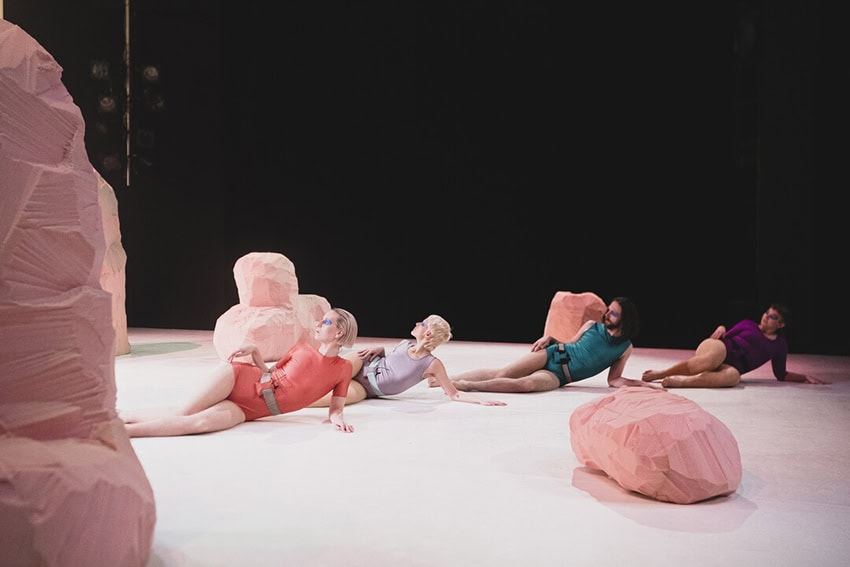Simone Mousset, Empire of a Faun Imaginary
Posted: March 11th, 2023 | Author: Nicholas Minns | Filed under: Performance | Tags: Alberto Ruiz Soler, Birte Meier, Eevi Kinnunen, Emilie Mathieu, Hannah Parsons, Jamie McCarthy, Lewys Holt, Lou Cope, Lydia Sonderegger, Macon Holt, Neil Callaghan, Seth Rook Williams, Simone Mousset, Sophie Ruth Donaldson, Tasha Hess-Neustadt, Vasanthi Argouin | Comments Off on Simone Mousset, Empire of a Faun ImaginarySimone Mousset, Empire of a Faun Imaginary, The Place, February 28, 2023

If you take each word of the title and consider what it represents — its lines of influence and significance — and then multiply each by the other two and then by time and space, you get a surreal blend of history, myth, and evolution that forms the mere starting point of Simone Mousset’s latest work, Empire of a Faun Imaginary. Clearly no linear framework can accommodate such a vast canvas, so Mousset has created with her performers and collaborators a three-dimensional fable with no beginning and no end, revealed within the theatrical convention of the rising and the extinguishing of the lights.
Four lascivious fauns (Tasha Hess-Neustadt, Lewys Holt, Eevi Kinnunen and Hannah Parsons) with bold eye makeup and costumed (for the women) in Birte Meier’s almost invisible hirsuit tights, appear displaced but poised in a neat diagonal in Lydia Sonderegger’s parched landscape with faded terra-cotta-coloured sculptural rocks. Under Seth Rook Williams’ lighting we see an almost flat plane like a painting, with the accented colours of Sonderegger’s costumes bringing the dancers into relief. There is a clear reference to the flat perspective and turned-in shape of Nijinsky’s faun but no sooner are we allowed to take this in than the dancers dissolve it into animalistic expressions of feral solitude in which their vocal agility conveys the uncanny disparity between human and animal. Jamie McCarthy is credited with the ‘voice work and vocal composition’ whose effect develops from the initially comic — especially with an almost camp interpretation of faunic movement — to the disturbingly visceral as Alberto Ruiz Soler’s soundscape blows in over the action like a weather front.
The action is slow enough that we can follow where Mousset takes us but she never goes where we expect; she is constantly destabilising us with her wry yet compassionate humour that helps us to grasp the enormity of her proposal. As the program note states, ‘Yearning for transformation and new futures, Empire of a Faun Imaginary is a melancholic world in search of the miraculous, that asks: How can we go on, and how can we dream again?’. The scale of time she employs is so vast that it diffuses any direction to the action; it is as if Mousset is giving theatrical life to a consciousness that is bubbling up from deep within her life and searching to make sense of the world and its many mysteries, especially death. The four fauns, who are oblivious to any time span but the present, at first follow their instincts as they map out their proscribed space with casual and sometimes hilarious abandon — until one of them dies. Fear and grief transform the atmosphere. The voices of the survivors become the physical and psychological extensions of their bodies; Parsons, in particular, extends the range of emotion to startling levels in her vocal pyrotechnics. And then Mousset changes tack with delicious irony to a parental bedtime conversation projected on to two mute rocks (whose immutability is later challenged), followed by the entrance of a mangey mammoth (created by Sophie Ruth Donaldson and Emilie Mathieu) whose longevity signals life’s overarching continuity and the expedience of reincarnation. Once again, Mousset steers a course through hazardous spiritual terrain, but even if we can’t ignore the ineffable sense of existential dis-ease that pervades Empire of a Faun Imaginary, its pessimism is mitigated by Mousset’s surreal humour and her unfettered embrace of life’s complexities that suggests a way through.
Crafting a compact theatrical work from such profound material requires a team in whom the artist can collaborate with complete trust. Apart from those already been mentioned above — and there is welcome continuity in that some have worked with Mousset on previous projects — Neil Callaghan is credited as ‘artistic companion’, Macon Holt as cultural theory consultant, Vasanthi Argouin as producer and in Lou Cope as dramaturg Mousset has evidently found a sympathetic spirit capable of disentangling threads and allowing them to find their place and significance in the finished schema.
Mousset is currently a Work Place Artist at The Place, which helps to sustain a current group of eleven artists and to ‘provide conditions for their work to grow and flourish over a five-year period.’ She has written on the Work Place site that ‘making things up and dancing and moving is a way for me to try and save myself, and potentially others, from a sense of general hopelessness.’ With this welcome first UK performance of Empire of a Faun Imaginary, she has also raised dance to a level of discourse that not only saves but enriches.